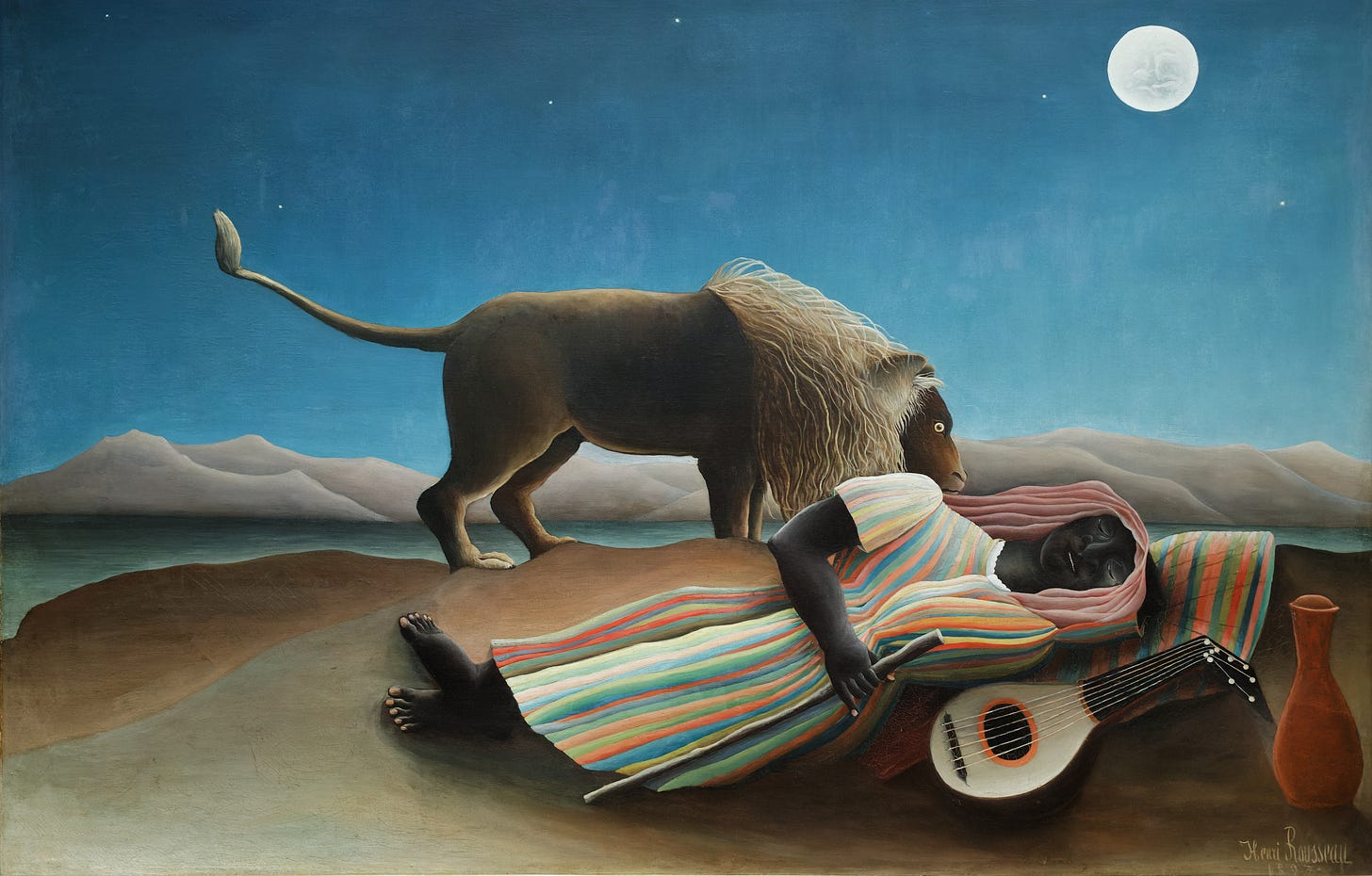Episode 035: The Sleeping Gypsy
In which we discuss tax collecting, drones, and The Simpsons
Henri Rousseau. He didn't find his thing until his 40s. Worked as a tax collector for much of the time he was painting. Most critics thought he stunk.
It seems we live in a time where increasingly you can’t be considered a real artist unless you are financially successful at it. Yet so many of the great artists of the past – and certainly of today as well – have had to support their art by working at all sorts of ‘normal’ jobs.
T.S. Eliot was a banker. The great Charles Ives was an insurance executive.
Phillip Glass: plumber.
Toni Morrison: editor.
Herman Melville: customs inspector.
Vivian Maier: nanny.
And many of these aren’t before-they-were-famous situations, these are the-whole-time-they-were–creating-their-art situations.
Maier was a nanny for 40 years!
I’m just imagining Rousseau coming home from a long day of enforcing tax laws in 1897 Paris, sitting down and saying, ‘Hey, I guess I’ll paint something!’ and out comes The Sleeping Gypsy. Ho-hum.
So anyway, art. Go make some.
I don’t always go for the most iconic paintings, but file this one under iconic: it’s on permanent display right next to Starry Night at MOMA. Not bad.
But that’s not where I discovered it. That discovery first came from a Simpsons episode. Actually, I've learned a lot from the Simps over the years.
Not the most straight-ahead reduction for me. So much to include: the subject, the lion, the mandolin, the jug, the moon. (The mountains didn’t make the cut.)
The robe. I try to stay away from a lot of small objects, but the multiple long stripes worked here.
I may have made the moon too small. But if you look at the original…it's pretty small!
This beat needed to be dreamlike. A discordant lullaby for the sleeping woman.
I’m playing the main theme with four or five different string and synth patches, all garbled and effected up to make it sound really dreamy. Very slow attack – each note fades in a bit late.
The strumming guitar drone runs throughout the piece. It’s upfront at the intro and coda and during the quiet sections, but it retreats to the background while the main theme is playing.
Had to be some sort of strumming happening with her mandolin lying next to her, right?
Let's talk about that drone. This was a typical way that I create drones that run underneath many of my beats:
Create a loop by strumming a guitar or playing a string patch or yelling into a microphone or whatever, generally in a completely different key than the rest of the song (tension!)
Duplicate the loop by playing it a half step higher or lower.
Turn the samples around so they play in reverse (sometimes).
Pan them nearly hard left and hard right.
Add fuzzy effects
Et voilà, an eerie-sounding background drone to set any mood!
It is not lost on me of course that today the term ‘Gypsy’ is considered offensive to the Romany people. [HERE is some basic info].
I just love the painting, and unfortunately, the word is in the title.
Nothing I have read makes me think that it was anything other than Rousseau using a term commonly used at the time. The painting feels respectful to me.
Until next week, thanks for reading Polyester City. If you have any thoughts, please leave a comment by clicking the link above. If you know anyone who likes Music and Art and Stories [and The Simpsons], which is pretty much everyone, please consider sharing by clicking the link below.








Just past a fence circling my highschool fields (in Greece) Gypsies would camp every year. I’d stay close to that fence because I couldn’t help myself and they stared back, side-eyed and straight faced. They would filter into the small suburb we were staying near the school. Some who recognized me looked me in the eye when I put change into the cups in front of them.
Few artists make a living from their art during their lifetimes. Gallery owners prefer them dead anyway.
Another masterwork. The drone and baseline made this feel almost surreal and the scratches had me imaging a silent movie soundtrack filled with suspense and tension. Your words about artists having regular jobs reminded me of a the greet book, “Real Artists Have Day Jobs” by Sara Benincasa